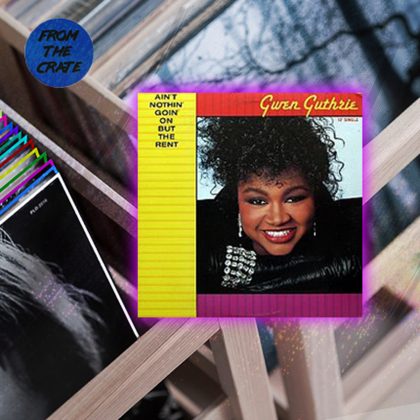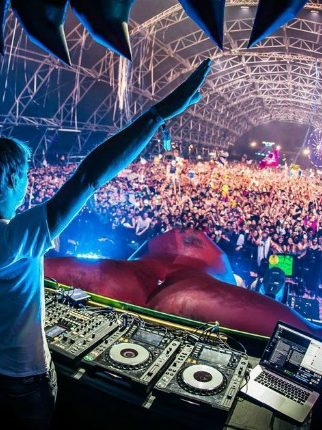New York Nightlife Gone: The Paradise Garage 1977–87
“For Larry, a place like the Garage was a dream come true. He had tremendous input and control, and he impacted every aspect of that venue. It was remarkable what he was able to do there.” —Danny Krivit
“The Garage was so blatantly superior to anything else going on. Larry built a relationship with the dancers that went past just a few hours—it was lifelong and deeply felt. Spiritual. It actually changed your life.” —Francois Kevorkian
Larry Levan stands as an icon in modern music, considered by many to be the most seminal figure in contemporary dance culture. The DJ. Larry built a residency unlike any other and architected a unique temple: The Paradise Garage.

There was an old parking garage on King Street in Manhattan’s West Village. David DiPino—a friend of Larry’s, who would end up opening for him, eventually becoming a successful DJ in his own right—had a memory of this large space, and looked up and down side streets until he found it. He got the address to Larry, and with the financial backing of Michael Brody, they took over the venue. The space was so large that in its first year, they threw construction parties to help with the build-out costs.
“I remember going to one of the early construction parties,” says legendary Body & Soul DJ Danny Krivit. “It was packed and hot. I commented to a friend about how the air conditioning was dripping on me. ‘What A/C?’ they laughed. It was the humidity dripping from the ceiling.”
When completed, the Garage—whose business model was inspired by David Mancuso’s legendary Loft parties—was a members-only club that catered to a predominantly black and Latino gay crowd. It had changing rooms, a chill-out area, a non-alcoholic bar, a large, tricked-out DJ booth, and a sparse, giant dancefloor. Sometimes, weather permitting, the dancers would escape the heat by going up to the roof.
“It wasn’t a chi-chi place; it wasn’t Studio 54”, recalls DiPino. “This was the underground, but it was a super clean and well organized, minimal space. Each room had its function.”

“People really cared—the staff and the patrons,” recalls Joey Llanos, who started doing security and later moved up to opening for Larry and forging his own DJ career. “It was our temple, and members treated it accordingly. A famous example was Larry stopping the music, getting a ladder, and cleaning the disco balls because he thought he saw some dust.”
The motor of the venue was its sound system—a tremendous, ongoing work in progress by famed sound designer Richard Long—which was constantly tweaked with, fussed over and upgraded by Larry and Richard. “Michael Brody would see Richard show up with a new piece of equipment,” remembers Krivit. “He would ask how much, [and] Richard would say, ‘Oh we are just trying this out, no cost right now’—to which Michael would respond, ‘You might as well tell me. I know eventually I am going to have to pay for it.”
Having an unprecedented level of involvement and authority, Larry expanded his role to every aspect of the venue—sound, lighting, design, security, curating the live acts, and having a say in who became members. He was a ubiquitous presence and used that license to fine-tune all of the components so that each night was rendered for maximum transformative effect.
“It is important to remember how great Larry was at working the lights,” states Joey Llanos. “He had this satellite mixing board on a track overhead for when he wanted to take over from the main lighting person. When I first met him, he was peaking a record and mixing the lights! I never saw anything like it before.”
“Larry yearned for more than technical perfection. He wanted inspiration, ecstasy. He wanted to spin the way he lived, in inspired anarchy.”
“Larry’s control of the environment was all-encompassing,” recalls Krivit. “If he did a blackout, he turned off the exit lights. You couldn’t see your hand in front of you—total darkness. He manipulated the temperature of the room, the system, the lights. You were fully immersed. I remember him playing ‘Why’d Ya Do It?’ by Marianne Faithfull. He made the entire room this deep red, [and] the mix of the all-red room and the brutality of the song created the most intense feeling. It was physical.”
Another major component of Larry’s nights were the live acts that he would select to perform—artists like Luther Vandross, ESG, Madonna, Kurtis Blow, Patti LaBelle and New Order. “I wasn’t a regular there,” recalls Liquid Liquid lead singer Sal Principato, “but the night we went in to play, we were going on after Chaka Khan around 5am. When I walked into that main room, it was like nothing I had experienced before or since. You had this phenomenal sound and incredible atmosphere; you could feel it going off. There was no doubt that this was the place. The environment, the DJ, and the crowd seemed like one.”
Starting from his initial gigs, Levan built a unique style that controlled the crowd, but also created tremendous intimacy and theatricality. He would play what he wanted, and he wasn’t afraid to empty the dancefloor. His commitment was to his feelings and his ideas. “It was very diaristic in a way; you could sense his moods,” remembers Krivit. “If he believed in a song—say, Taana Gardner’s ‘Heartbeat’—he would stay with that song. He might play it over and over, and then do the same thing the next week until it became a New York anthem.” Joey Llano recalls, “He said to me, ‘If you don’t empty the floor at least once a night, you aren’t being honest, and you aren’t doing your job properly.’”
West End Records president Mel Cherin stated it eloquently: “Larry yearned for more than technical perfection. He wanted inspiration, ecstasy. He wanted to spin the way he lived, in inspired anarchy.”
The Paradise Garage and Larry Levan embodied the height of the utopian underground disco spirit—a nirvana I think we still long for. It inspired so much, and his influence is felt to this day (the Ministry of Sound was an attempt at a Garage-like system and approach). Larry broke and made records; the nearby record shop Vinylmania started opening on Sunday mornings to accommodate people fresh out of the Garage, hungry for the jams Larry played.
He developed the idea of the club as a full sensory environment, and he took the role of DJ as host (which David Mancuso pioneered) and pushed it to the level of an auteur. In conversation, regulars of the Garage tend to speak about it like someone who has been to Yosemite or the Himalayas, with a look that says, “I can try to explain, but unless you were there, it is hard for you to know just how life-changing it was.”



